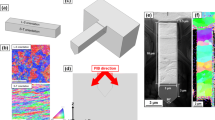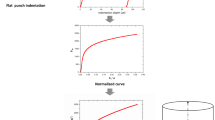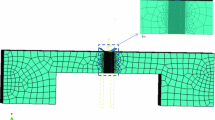Abstract
Plane-strain fracture-toughness tests were performed using the recently proposed round-bar bend test procedure with a liquid-phase sintered tungsten alloy. The tests included a direct comparison of fracture toughness from rectangular and round-bend specimens and measurements of load-line compliance using the unloading technique ofJ-integral fracture tests. Complementary displacement and crack-growth stability analyses of the round bar were performed as an extension of recent work in these two areas.
Similar content being viewed by others
References
Bush, A.J., “Experimentally Determined Stress-Intensity Factors for Single-edge-crack Round Bars Loaded in Bending,”Experimental Mechanics,16,249–257 (1976).
Underwood, J.H. andWoodward, R.L., “Wide Range Stress Intensity Factor Expression for an Edge-Cracked Round Bar Bend Specimen,”Experimental Mechanics,29,166–168 (1989).
“Standard Test Method for Plane-Strain Fracture Toughness of Metallic Materials, ASTM Method E399,” Annual Book of ASTM Standards, 03.01, ASTM, Philadelphia, 485–512 (1990).
Baratta, F.I., “Load-Point Compliance of a Three-Point Loaded Cracked-Notched Beam,”J. Test. and Eval.,16,59–71 (1988).
Baratta, F.I. andDunlay, W.A., “Crack Stability in Simply Supported Four-Point and Three-Point Loaded Beams of Brittle Materials,”Mech. of Mat.,10,149–159 (1990).
Underwood, J.H. andScavullo, M.A., “Fracture Behavior of a Uranium or a Tungsten Alloy Notched Component with Inertia Loading,”Fracture Mechanics: Sixteenth Symposium, ASTM STP 868, ed. M.F. Kanninen andA.T. Hopper, ASTM, Philadelphia, 554–568 (1985).
Underwood, J.H. andWitherell, M.D., “Load-Line Displacements for Three-Point-Bend J Tests Using Bottom Surface Displacements,”Eng. Fract. Mech.,37 (6),1277–1278 (1990).
Clausing, D.P., “Crack Stability in Linear Elastic Fracture Mechanics,”Int. J. Fract. Mech.,5,211–226 (1969).
Bluhm, J.I., “Stability Considerations in the Generalized Three Dimensional Work of Fracture Specimen,” Fracture 1977,3,ICF4, Waterloo, Canada, 409–417 (1977).
Paris, P.C., “The Mechanics of Fracture Propagation and Solution to Fracture Arrestor Problems,”Document D-2-2195, The Boeing Co., Seattle, WA (1957).
Underwood, J.H., Kapp, J.A. andBaratta, F.I., “More on Compliance of the Three-Point Bend Specimen,”Int. J. Fract.,28,R41–45 (1985).
Tada, H., Paris, P.C. andIrwin, G.R., The Stress Analysis of Cracks Handbook, Paris Productions Inc., St. Louis, 9.1 (1985).
Timoshenko, S., Strength of Materials, Part I, 3rd Ed., D. Van Nostrand Co., New York (1958).
“Standard Practice for R-Curve Determination, ASTM Practice E561,” Annual Book of ASTM Standards, 03.01, ASTM, Philadelphia, 571–582 (1990).
Author information
Authors and Affiliations
Rights and permissions
About this article
Cite this article
Underwood, J.H., Baratta, F.I. & Zalinka, J.J. Fracture-toughness tests and displacement and crack-stability analyses of tungsten round bend specimens. Experimental Mechanics 31, 353–359 (1991). https://doi.org/10.1007/BF02325993
Received:
Revised:
Issue Date:
DOI: https://doi.org/10.1007/BF02325993




